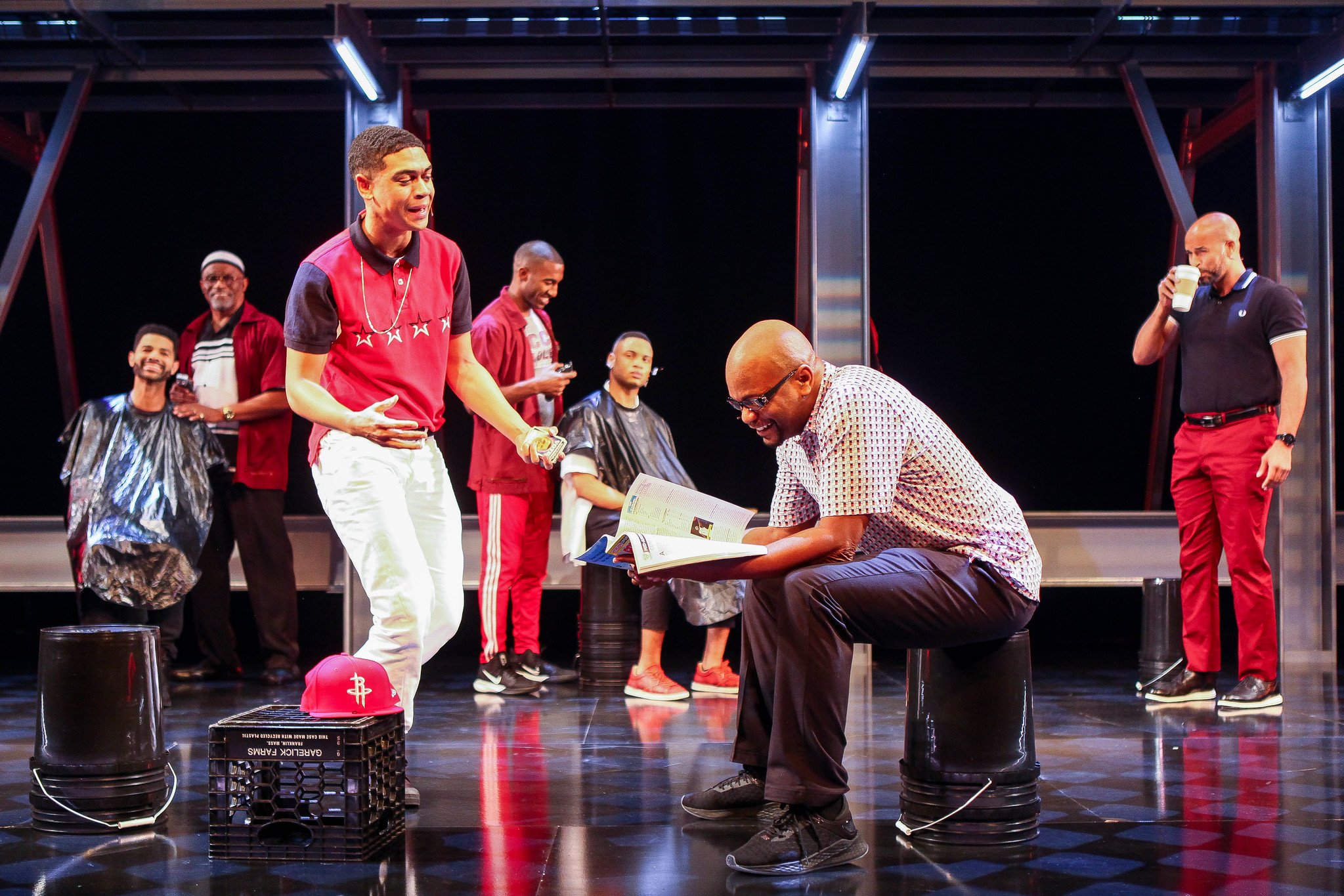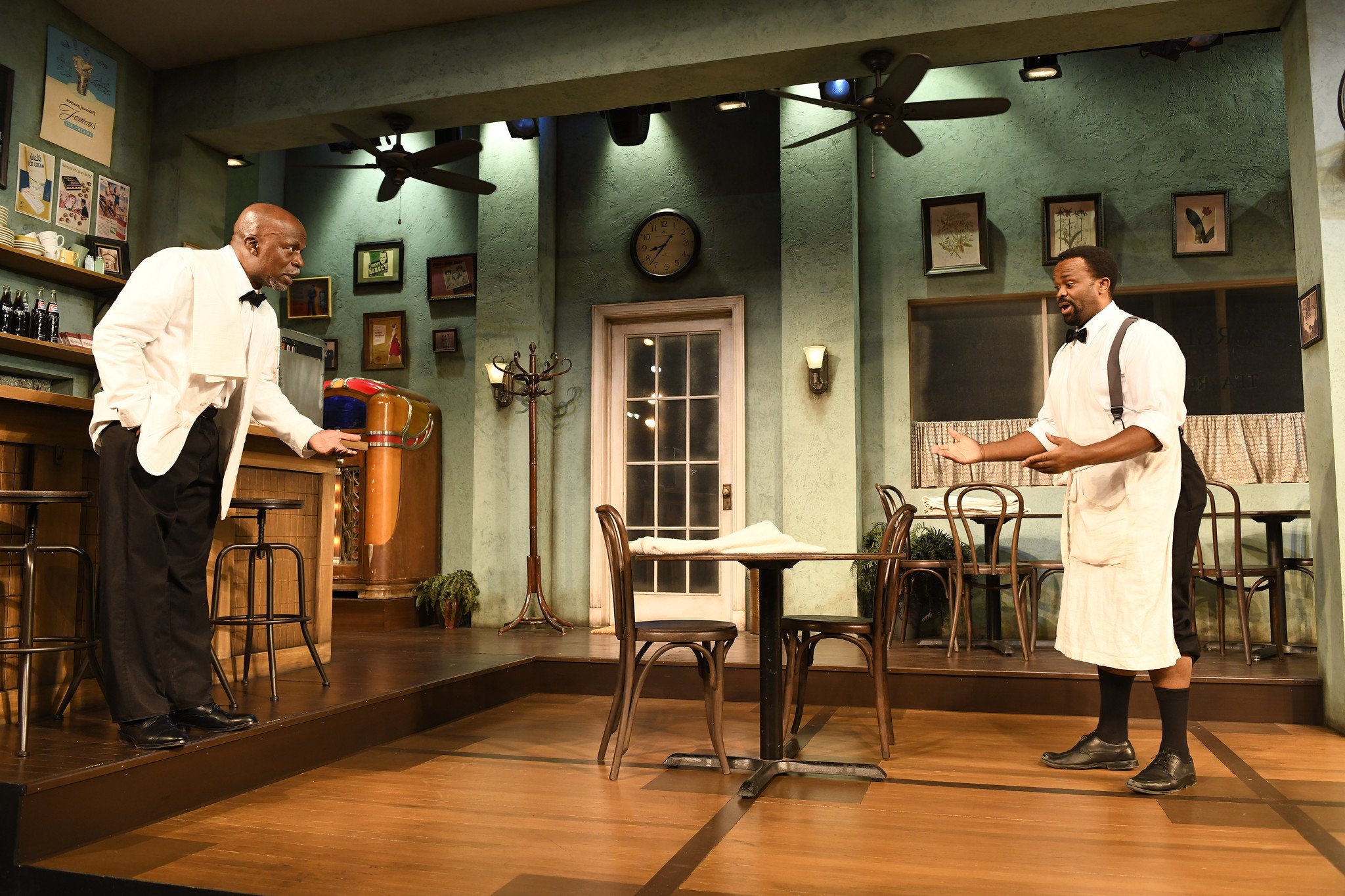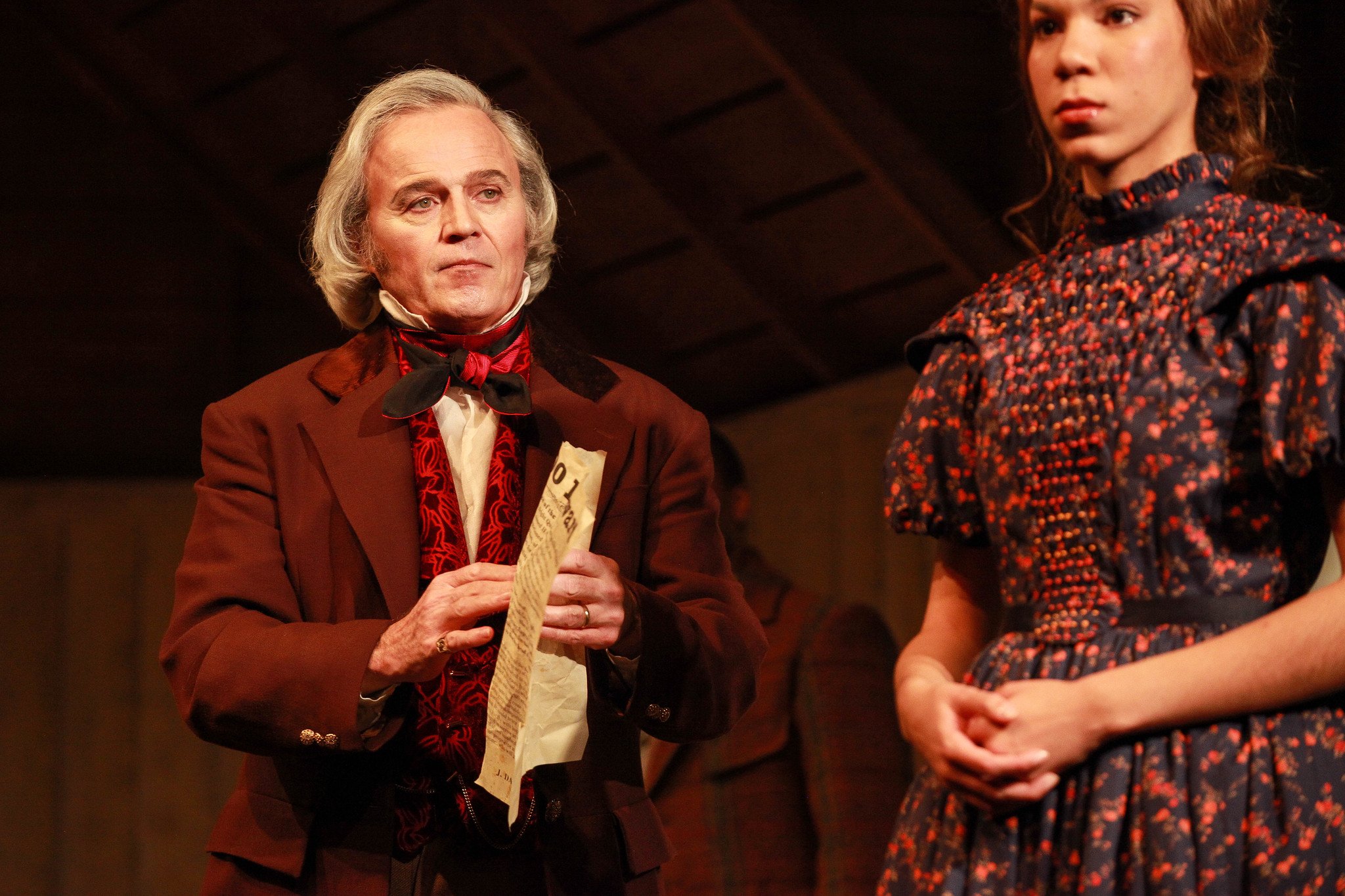
EASIER SAID THAN DONE:
Syracuse Stage Reopens for Live Performance
Jason O'Connell, Laura Yumi Snell, Stephanie Weeks, Drew Hirshfield, and LeeAnne Hutchison in "Eureka Day" at Syracuse Stage, Oct. 13 - 31, 2021. By Jonathan Spector. Directed by Robert Hupp. Photo: Mike Davis
In May of 2021, then New York governor Andrew Cuomo announced that Broadway theatres would open at full capacity in the coming September, a full 18 months after they were ordered closed due to the Covid pandemic. While the news was welcomed throughout the theatre world, producers and artistic leaders recognized that the journey back to pre-Covid norms would be long and fraught. Consequently, at Syracuse Stage, the genuine joy at the prospect of once again sharing live theatre with an audience was tempered by lingering and serious uncertainties. Chief among these were questions concerning the conditions under which patrons would feel safe and comfortable sitting shoulder to shoulder in the theatre, if indeed they would return to the theatre at all.
That Syracuse Stage patrons were exceedingly loyal and supportive was never in question. Throughout the forced closure, many patrons continued to contribute financially to the theatre directly or by simply donating their unused tickets in lieu of refunds. Deeply appreciated, this generosity had been a source of inspiration and comfort during the worst days of the pandemic, and with reopening a real possibility, a cause for optimism. Nevertheless, no one expected patrons to abandon their legitimate concerns about the serious health threat still posed by Covid just to attend a performance. Thus, as plans were formulated for a new in person season, Stage pledged to adhere to all recommended safety guidelines. The doors would open, but masks would be required as would proof of vaccination or a recent negative test. “Welcome to Syracuse Stage. May I please see your Covid card?” If not the friendliest of greetings, instituting and adhering to the most updated precautionary guidelines throughout the season demonstrated Stage’s commitment to the safety of artists, staff, and patrons alike.
With plans underway for producing six mainstage shows and additional community focused programming, Stage made a significant announcement about the artistic leadership. In July, Melissa Crespo became Stage’s associate artistic director, the first woman to hold an artistic leadership position at Syracuse Stage. Crespo’s association with Stage began in 2019 when she directed the highly popular comedy Native Gardens and continued in 2021 with the online production of I & You. She would direct the much-postponed Yoga Play in the 2021/2022 season. In inviting Crespo to join Stage’s artistic leadership, Hupp signaled a deepening commitment to creating new work. Crespo had spent a considerable part of her career to date developing new plays, musicals, and operas and she was the co-author (with Sarah Saltwick) of the play Egress, which was a winner of the Roe Green Award for Outstanding Achievement in Playwriting at the Cleaveland Play House.
Melissa Crespo
Anne-Marie Cusson, Paul DeBoy, Erick González, and Monica Rae Summers Gonzalez in "Native Gardens" at Syracuse Stage. Directed by Melissa Crespo. Scenic design by Shoko Kambara. Costume design by Lux Haac. Lighting design by Dawn Chiang. Sound design / original music by Elisheba Ittoop. Photo by Michael Davis.
Cole Taylor and Phoebe Holden in "I and You," streaming on demand May 5 - 23, 2021. By Lauren Gunderson. Directed by Melissa Crespo. Scenic Design by Shoko Kambara. Costume Design by Lux Haac. Lighting Design by Dawn Chiang. Sound Design by Elishiba Ittoop. Photo by Brenna Merritt.
Crespo succeeded Kyle Bass who at the same time was named the company’s first resident playwright. Bass’s long association with Stage began in 1994 and included serving as resident dramaturg during Tim Bond’s tenure. He was named associate artistic director by Hupp in 2016. In that capacity, he had been a strong advocate for making the development of new work an integral part of Syracuse Stage’s mission. It was therefore appropriate that as the theatre reopened, the season would begin with a reading of Bass’s play Baldwin vs. Buckley: The Faith of Fathers, an adaptation of the famed 1965 televised debate between James Baldwin and William F. Buckley and conclude with his play salt/city/blues, an original work inspired by the city of Syracuse.
Faith of Our Fathers had just three performances. It constituted what is referred to as a soft opening, a small-scale performance before the full-scale mainstage season began. Still, the sight of actors live onstage, the sound of their voices resonating throughout the Archbold Theatre, and the eloquence, particularly of Baldwin’s words, which Bass included verbatim from the debate, signaled something much larger. Theatre was back. Syracuse Stage was open again and ready to welcome artists back to work and audiences back for the kind of experience only theatre can offer. It seemed fitting that for this reopening production most of the visiting artists previously had worked at Stage: director Godfrey L. Simmons (actor Blues for an Alabama Sky and A Raisin in the Sun), L. Peter Callender (“Master Harold” . . . and the Boys and The Comedy of Errors), Wynn Harmon (Travels with My Aunt, Sylvia, and Possessing Harriet), Reynaldo Piniella (Thoughts of a Colored Man), and Robbie Simpson (Department of Drama alumnus and Great Expectations). It seemed equally significant that each of the three scheduled performances was followed by a moderated talk back and that one of those performances was set aside specifically for an audience of 300 incoming first year Syracuse University students, thereby highlighting theatre’s ability to generate an exchange of ideas and reach across generational divides.
Kyle Bass

The cast of "Thoughts of a Colored Man" in the world premiere at Syracuse Stage. September 4 - 21, 2019. By Keenan Scott II. Directed by Steve H. Broadnax III. Choreography by Millicent Johnnie. Scenic design by Robert Brill. Costume design by Toni-Leslie James and Devario Simmons. Lighting design by Ryan J. O'Gara. Sound design by Mikaal Sulaiman. Projection design by Sven Ortel. Music by Te'La and KAMAUU. In association with Baltimore Center Stage, Brian Moreland, and Ron Simons. Photo by Michael Davis.

L. Peter Callender and Phumzile Sojola in Syracuse Stage's production of "'Master Harold'...and the Boys," streaming on demand June 16 - July 4, 2021. By Athol Fugard. Directed by Gilbert McCauley. Scenic design by Riw Rakkulchon. Costume design by Kara Harmon. Lighting design by Rachael Blackwell. Sound design by Amy Altadonna. Photo by Brenna Merritt.

Rand Foerster, Jeremiah Packer, and Leo Finnie in "salt/city/blues" at Syracuse Stage. June 9 - 26, 2022. Written by Kyle Bass. Directed by Gilbert McCauley. Scenic design by William Bloodgood. Costume design by Devario D. Simmons. Lighting design by Kathy A. Perkins. Sound design by Gregory Robinson. Choreography by Olivia Lacie Andrews. Composer: James Gordon Williams. Fight Director: Alec Barbour. Associate Lighting Designer: David M. Bowman. Production Stage Manager: Stuart Plymesser. Casting: Bass/Valle Casting. Photo by Brenna Merritt.

Rishan Dhamija, Ricky Pak, and Andrea Cirie in the Syracuse Stage production of "Yoga Play." In person performances January 19 - February 6, 2022. Streaming on demand January 31 - February 20, 2022. By Dipika Guha Directed by Melissa Crespo Scenic design by Ann Byersdorfer Costume design by Johanna Pan Lighting design by Jeanette Oi-Suk Yew Sound design by Mark Van Hare Projection design by Lisa Renkel Dialect Coach: Susan Cameron Dramaturg: Sidikha Ashraf Associate Director: Caitlin Sullivan Production Stage Manager: Stuart Plymesser Co-produced with Geva Theatre Center Photo by Mike Davis

Wynn Harmon and Nicole King in the world premiere production of "Possessing Harriet" at Syracuse Stage, Oct. 17 - Nov. 4. Set Design: Donald Eastman. Costume Design: Carrie Robbins. Lighting Design: Stephen Quandt. Photo by Michael Davis.
Was it madness or genius? A fair question to ask of Hupp’s decision to make Jonathan Spector’s unsettling comedy Eureka Day the official season opener. How would audiences respond to a play that confronts head on a controversy about vaccines? Weren’t they all living it in their daily lives as the Covid vaccine became a political and cultural football? Weren’t most of them wondering why a handful of individuals found it impossible to wear a mask properly? Actually, for Hupp, that was precisely the point.
“Eureka Day is actually a richer experience today than when it first came to our attention two years ago,” Hupp explained at the time. “What was far-fetched craziness then is reality now.”
Spector began writing Eureka Day in 2016 and it had several well-received productions prior to Covid. The vaccine in question in the play is mumps and the outbreak is confined to a progressive Day School in Berkley, California. The stakes are certainly serious for the characters, and Spector treats their concerns with an even hand and finds the imperfect humanity in each of them. As the world tip-toed back from Covid, Hupp believed audiences would be receptive to the struggle engulfing the administrators and parents at the school.
“At its core, it is a funny and moving play about the conflict between personal choice and the greater good,” he said. “This play, and this production, give us permission to laugh at the absurdity of the world around us and to wrestle with our own feelings about who gets to decide the thorny question of what’s right for our community.”
While Eureka Day succeeded as the season opener, getting through an entire season would present a number of challenges. In addition to the guidelines governing audiences, Stage had to develop and implement protocols to ensure the safety of artists and crews in rehearsal and performance. In essence, a bubble had to be created around the process. Only those crucial to the production would be allowed in the rehearsal room. Everyone in the room would have to be tested twice weekly and everyone would have to be vaccinated and masked. As the season opened, Stage sent out a communication assuring patrons that 100% of employees and visiting artists were fully vaccinated. Still, in truth, no one expected to get through year without Covid breaching the safety bubble. Hope for the best; prepare for the worst.
In this case preparing meant trying to be sure that every role would be understudied, not a common practice in regional theatre, nor at Syracuse Stage, mostly because of the expense. Along with the testing protocols and other safety measures, providing for understudies made producing considerably more expensive. There was, however, no alternative, and as the next show would demonstrate, until Covid was effectively neutralized, even the most comprehensive preparations might not be enough.
With a cast of 30 including New York professionals, Department of Drama faculty, Drama students, and local children, Roald Dahl’s Matilda The Musical was, to misuse and borrow from Shakespeare, “such stuff as dreams are made on:” the dream of once again delivering a big and fun filled family musical to Central New York for the holidays, the dream that director Donna Drake and music director Brian Cimmet along with choreographer Andrea Leigh-Smith would realize the full artistic potential of Dennis Kelly and Tim Minchin’s show, and the dream that a corner had been turned in the disruptive impact of Covid. Not to be, not yet.
Despite vaccinations, testing protocols, mask requirements, closed rehearsals, and a ban on socializing outside the bubble, Covid could not be stopped. No one was really surprised. It had always been a matter of when, not if. To that end, Donna Drake and Bob Hupp had in place a full contingent of understudies and swings, but as with any sports team, a bench is only so deep. For a long stretch, stage manager Laura Jane Collins had to rearrange cast assignments for every performance, never having the same cast two performances in a row. The professionals and students rose to the challenge, in some instances covering roles for which they had not been assigned originally and with minimal rehearsal. The show went on until there simply weren’t enough players to play the play. The final two weeks of the run were canceled.
If the forced cancelation was disappointing, it was also in its way instructive. There is a difference between disappointment and discouragement. Hupp, Anderson, and the Stage staff refused to give into the latter. There was much to be proud of in the sheer effort it took to get such a large and complicated show to the stage under such trying conditions. The artistic team—Drake, Cimmet, and Leigh-Smith—had delivered a first-rate production buoyed by the outstanding design team of Czerton Lim (scenic), Ryan J. Moller (costumes), Thomas C. Hase (lights), Jacqueline R. Herter (sound), Brian McMullen (projections) and Jason Kyle Estrada (wigs). The cast was heroic led by Drama faculty member Kathleen Wrinn as Miss Honey and child pro Annabel Cole and Drama student Emerson Glick sharing the role of Matilda. Luke Darnell and Kim Sava were deliciously sleazy as Matilda’s neglectful parents and faculty member David Lowenstein excelled as the diabolical Miss Agatha Trunchbull. They were all supported by what proved to be a most versatile ensemble.
It was also true that there was no time to indulge discouragement. As the calendar page flipped and 2021 became 2022, the demands of mounting four more shows needed to be addressed. First up was the much delayed comedy Yoga Play, which had been scheduled and canceled twice. The show represented Melissa Crespo’s first directorial assignment as Stage’s new associate artistic director and she was pleased with the opportunity.
“We all need to laugh right now,” she explained at the time. “Yoga Play mirrors what we are feeling when we work too much and prioritize greed over humanity. It encourages us to slow down, to meditate, and have more empathy for each other.”
For his part, Hupp strove to reassure patrons that Stage was determined to continue with the season while maintaining safety as the first priority.
“We’ll continue to produce work in the context of the safety guidelines and best practices outlined by our unions, Syracuse University, Onondaga County, and the CDC,” Hupp said. “Provided we can do so in a manner that is safe for our audience, staff and artists, we will do our best to offer relief and refuge and provide a ray of optimism and a sense of community for all.”
Yoga Play was the first production in the season to be videoed and made available online. Complications with professional unions and license holders for the various plays meant that Stage would not be allowed to video all of the shows. Like workplaces throughout the world, the theatre industry was navigating a new and changing landscape the regulations for which were a work in progress at best.
Ricky Pak, Rishan Dhamija, Christopher Gurr, and Andrea Cirie in the Syracuse Stage production of "Yoga Play." In person performances January 19 - February 6, 2022. Streaming on demand January 31 - February 20, 2022. By Dipika Guha. Directed by Melissa Crespo
The next show was the first of two world premieres scheduled for the season, Brian Quijada’s original musical Somewhere Over the Border, directed by Rebecca Martínez with music direction by Julián Mesri, both newcomers to Syracuse Stage. In Somewhere Over the Border, Quijada told the story of his mother’s journey from El Salvador to the U.S. in the 1970s. She was a teenager and a single mother who had to her leave her son behind and make the journey alone. The show recounts her decision and journey and eventual return to El Salvador to reunite with her child. Quijada explained that for many years he had known some but not all of his mother’s story. One night on a long phone call, she filled in the details. As she spoke, Quijada said, it felt like she was relating an epic and familiar tale. Soon after the conversation he placed it: The Wizard of Oz. Attaching his mother’s story to the structure and characters of The Wizard of Oz was the genesis of the show. The music drew on contemporary styles as well music rooted in the cultures of the countries through which his mother traveled.
Stage produced Somewhere Over the Border in partnership with the Geva Theatre in Rochester and Teatro Vista, Theatre with a View in Chicago. After the Syracuse Stage run, it opened at Teatro Vista and won three Chicago Jeff Awards including Best Musical (Midsized). The commitment to supporting new voices and producing new work made by Hupp, Bass, and Anderson pre-Covid, proceeded unabated and was having impact beyond Central New York.
A good laugh is always welcome (and needed), and sometimes the wilder, whackier, and sillier the laugh the better. Enter with pratfalls, malfunctioning props, and collapsing set pieces—The Play that Goes Wrong. The over-the-top farce had a long history in London’s West End and Off-Broadway in New York but had not been licensed for regional theatre. Stage’s production was one of the first and was directed by Hupp and featured a cast with several familiar faces including Jason O’Connell, Kate Hamill, Angie Janus, and Seth Andrew Bridges (who was back for his fifth time). Czerton Lim designed the set, which he described as almost another character in the show with a mind of its own and competing with the actors for attention. As Hupp noted, “a lot has to go right for this play to go wrong.” Judging by audience and critical response, it went very wrong (right). And while it wasn’t a totally Covid free run, coverage by the understudies prevented the cancelation of performances.
The end of the first post-Covid season coalesced around three events, two shows at Syracuse Stage and an exhibition at the Everson Museum, all of which touched on the controversy surrounding the construction of I-81 and the destruction of the 15th Ward in Syracuse. All were also part of Syracuse’s Juneteenth Celebration. The first show was the season’s final mainstage presentation, the world premiere of Kyle Bass’s salt/city/blues. The second was an experimental performance of The Most Beautiful Home . . . Maybe by artists and activists Mark Valdez and ashley sparks (known as Marks & sparks). The third was an exhibition 15-81 featuring the project We Outchea: Hip-Hop Fabrications and Public Space by architect and urban designer Sekou Cooke.
Bass set salt/city/blues in a neighborhood bar (based on The Penny on the fringe of Armory Square) located near an elevated highway earmarked for dismantling. When built, the highway was controversial because it divided the city and gutted a thriving neighborhood that was home to many Black families and businesses. The fate of the bar and a handful of regulars is now uncertain. New to the bar is a Black professional woman named Yolanda Mourning who is serving as a consultant to the city on the dismantling of the highway. She has a 17-year-old son and is recently separated from her husband. She is trying to reset her dismantling life.
Gilbert McCauley (“Master Harold” . . . and the Boys) directed salt/city/blues and found the connection beyond the fictional bar. “This is a story about a town and a bar at a crossroads, and five people who are at crossroads in their lives,” he explained. “We often arrive at places where we have to make decisions and figure out what direction to take. That’s what facing these characters, and what we face today, even as a nation, as a country. Where are we going?”
Add to that question “and how do we get there” and the genesis of The Most Beautiful Home . . . Maybe becomes clear, although within a much more specific focus. Valdez and sparks developed the show to examine how theatre could be used to help find solutions to the housing crisis impacting many cities. Through workshops that brought together stakeholders involved in housing policy—politicians, developers, advocates, activists, the homeless—Valdez and sparks sought creative solutions to housing insecurity by challenging participants to consider the question “What if everyone in this country had a home?” The input collected at the workshops formed the basis for the performance piece. Syracuse Stage hosted four such workshops in the lead up to the performance and local participants have included Deka Dancil, Manager of Bias Response and Education at Syracuse University, Lanessa Chaplin, Esq., Project Counsel for the New York Civil Liberties Union, and author and playwright Dr. Juhanna Rogers, among others.
Supported by a grant from the Mellon Foundation, The Most Beautiful Home . . . Maybe performed in Minneapolis, MN, at the Mixed Blood Theatre, and at Los Angeles’ REDCAT in the Walt Disney Concert Hall Complex. It had three performances in the Storch Theatre at Syracuse Stage. In speaking with the LA Times, sparks said that the skills theatre artists have “are actually superpowers for solving community problems and creating spaces for people to have hard conversations.”
The exhibit 15-81 presented Cooke’s project We Outchea: Hip-Hop Fabrications and Public Space alongside documents relating to Syracuse’s 15th Ward. Commissioned by New York’s Museum of Modern Art in 2021 as part of the exhibition Reconstructions: Architecture and Blackness in America, We Outchea focused on the legacy of placement and displacement of Black residents in Syracuse and considered various events in the city’s history—the razing of the 15th Ward, the building of multiple public housing projects, and the construction of Interstate-81—while simultaneously critiquing recent proposals to replace low-income communities with mixed-income housing. By contextualizing the We Outchea project with photographs and ephemera that told the story of the once vibrant 15th Ward, Cooke pointed to a post-81 Syracuse future of entrepreneurship and innovation.







